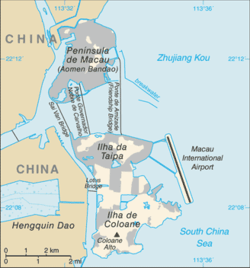Wanzai, Small Hengqin and Great Hengqin islands
Wanzai, Small Hengqin and Great Hengqin were three Chinese islands located to the west of the Macau Peninsula and the Macau islands of Taipa and Coloane. They were inhabited by very small Chinese population in its early history and have since been combined via land reclamation to form the current Hengqin island.
Wanzai, Small Hengqin and Great Hengqin islands 灣仔、小橫琴島和大橫琴島 Wānzăi、Xiăohéngqín Dǎo Hé Dàhéngqín Dǎo Lapa, Dom João e Montanha | |
|---|---|
 | |
| Region | Zhuhai / Macau (leased lands) |
| Time zone | UTC+8 (China Standard / Macau Standard) |
| Postal code | 519031 |

History
In some historical registers, the Portuguese presence on the island dates back to the end of the 17th century when a group of missionaries established themselves on this Chinese island.
During the 19th century, Portuguese missionaries also began to populate and evangelize the other two islands. The Macau government also began to collect taxes from the populations of these three islands in exchange for protection as these islands were not protected by Chinese soldiers. The Portuguese built a leper colony on the island of Dom João and some schools to educate the few Chinese residents on the islands.
Followed by the Japanese invasion of China in 1938, the Portuguese officially occupied these three islands, with an excuse to better protect Portuguese missionaries residing there. In 1941, the Japanese Army threatened the Portuguese troops to force abandonment of these sparsely populated islands. Consequently, these islands were occupied by Japan. At the end of World War II, China was able to reoccupy the three islands.
Today, they are an incorporation of the Special Economic Zone of Zhuhai in Guangdong. The islands of Dom João and Montanha are now connected by an embankment that joins the two islands. This island was given the Chinese name, Hengqin. The Lotus Bridge makes the connection between Hengqin of Guangdong province and Cotai of Macau Special Administrative Region. The island of Lapa, established from land reclamation became a peninsula connected to the "mainland".
There are proposals to develop sparsely populated Hengqin into a tourist area with many hotels and luxury resorts. Hengqin has recently begun to experience major development with new residential areas.
Macau, due to lack of land, expressed their desire to annex the island of Hengqin to the Chinese Central Government, which was subsequently denied by Beijing. However, on September 1, 2005, the Central Government allowed entrepreneurs from Macau and Hong Kong to be exempt from the payment of some taxes and fees. The CPG also allowed greater flexibility in controlling migration to the island to promote investment.[1]
Former islands
Wanzai
Wanzai (Chinese: 灣仔) was an island in the Xiangzhou District of the city of Zhuhai in Guangdong, China. It is adjacent to the Macau Peninsula of Macau. The Portuguese called the island Lapa .
Wanzai area in the east side of Ilha de Lapa was under Portuguese control from 1849 to 1887. It was located across the "Inner Harbor" (Qianshan Waterway) from Macau. In a 1700 map, the island has a defensive battery and manufacturing facility.[2]
Small Hengqin
Small Hengqin was a Chinese island adjacent to Taipa of Macau that has since and has become the northern part of Hengqin in Zhuhai, Guangdong. After land reclamation, only a swampy creek called "Central Creek(中心溝)" separates Small Hengqin from Great Hengqin.
The Portuguese called it Dom João (Chinese: 小橫琴島).
See also
References
- "China builds new global tourist magnet on Hengqin island". Reuters. Daily Sabah. 2017-09-17. Retrieved 2019-06-16.
- http://www.history-map.com/picture/002/Macao-1700s-in.htm